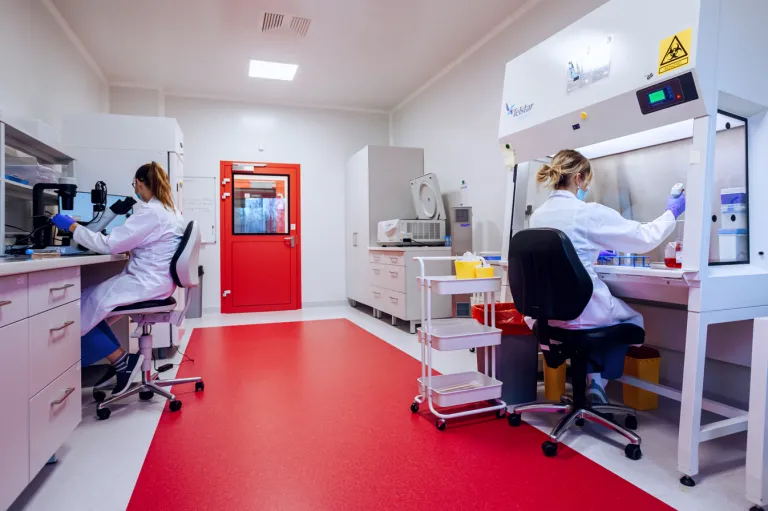The GBS test is a microbiological screening test that can detect the presence of group B streptococci in the human body. The abbreviation GBS comes from the English language; it is developed as Group B Streptococcus. GBS testing is performed on pregnant women to determine the possible risk of transmitting the infection to the baby during childbirth. GBS testing in pregnancy is very important for the health and life of the newborn.
Group B streptococcus – what is it?
GBS in pregnancy occurs due to the presence of bacteria of the Streptococcus agalactiae species, which are a component of the pregnant woman’s natural bacterial flora. They reside in the digestive tract and urinary tract, which probably affects their colonization in the vaginal area as well.
GBS – a test for pregnant women
Any pregnant woman between 35 should come in for GBS testing. and 37th week of pregnancy. Diagnosis is important because streptococcal infection does not actually produce any characteristic disease symptoms.
What does the GBS test look like?
GBS testing is quick and efficient. This short procedure involves taking a swab from the lower part or vestibule of the vagina or rectum using a specially adapted thin swab.
Taking a swab for GBS testing can be done by the pregnant woman herself, who has read the instructions beforehand. More often, however, they are performed by a doctor or midwife. GBS testing cannot be done with a speculum. After a sample is taken at the gynecologist’s office for the presence of group B streptococci, it is sent to a microbiology laboratory. Waiting for the results of the test takes about five days; it is worth noting that such a document a pregnant woman must take with her to the hospital. A microbiological screening test will show whether the patient has GBS streptococcus.
Prior to the test, sexual abstinence should be implemented; and don’t forget to observe intimate hygiene, which will prevent genital infections.
Does GBS lead to inflammation of the membranes?
We have already mentioned that GBS can develop in the genital tract of a pregnant woman. This disease does not give characteristic symptoms, so that the woman may not even know that she is a carrier. He usually finds out only when a swab is taken. A likely source of vaginal colonization is B-group bacteria, which are found in the gastrointestinal tract or around the urethra, among other places.
GBS infection can carry many consequences. One of them is the possibility of pneumonia, chorioamnionitis and endometritis. In some cases, GBS infection during pregnancy can lead to meningitis – which is a very serious condition and can even lead to the death of the woman. GBS in pregnancy is dangerous – so it is worth doing a GBS test to check the presence of group B streptococci and implement appropriate treatment.
GBS in pregnancy – what can it do to a newborn?
Infection of a newborn with a bacterium can lead to the development of a severe invasive disease. This will manifest itself, for example, in septicemia, which develops in the first week of a newborn’s life. GBS-related illnesses can appear even up to the third month of his life. Pneumonia or meningitis is also common; bone marrow inflammation and purulent arthritis can also occur.
What about after the GBS test?
We already know how the GBS test proceeds. What are the next steps? If pregnant women are GBS carriers, then the attending gynecologist must note this fact in the pregnant person’s chart. Documentation of this type should also include information on hypersensitivity or allergy to drugs.
Prophylaxis of GBS infection should take place between 35 and 37 weeks of pregnancy. Even in the absence of GBS carriage, certain procedures should be implemented – especially if the patient has given a medical history of perinatal infection with any of her previous children.
Those women who report to the hospital more than 18 hours after the rupture of the fetal membranes and if the pregnant woman develops a temperature higher than thirty-eight degrees Celsius should also be tested for GBS.
Prophylaxis should begin as soon as a woman is admitted to the hospital. Most often, penicillin G is administered immediately in an intravenous fashion. The first dose is 5 million units; subsequent doses are administered at 2.5 million units every four hours.
It is worth mentioning, by the way, that GBS infection during pregnancy is not at all a contraindication to collecting cord blood from the baby. This is because every single sample is given to test for bacteria, fungi and viruses. In addition, intrapartum antibiotic therapy makes the risk of GBS infection truly negligible.
GBS – what to do if it occurs in newborns?
GBS testing involves picking up lesions that clearly indicate infection. If the result is positive, then it is necessary to implement perinatal antibiotic prophylaxis in the pregnant woman. This action also forces observation of the child; the newborn must be under control for at least twenty-four hours. If there are any signs of infection during this time, the baby must be fully diagnosed. In this situation, the material for testing is taken from the ear and navel of the newborn.
Newborns over the thirty-fourth week of pregnancy who had no clinical signs of infection and whose mothers received perinatal prophylaxis less than four hours before delivery should also be observed for 24 to 48 hours. In this case, there is no need for a microbiological blood test. If no disease symptoms appear, then the child can be discharged from the hospital.
What other indications are there to perform a full diagnostic for the presence of group B bacteria in a newborn? Testing is performed when:
- the child’s mother has a fever above 38 degrees Celsius and one of the symptoms that can occur with vaginal colonization. We are talking about such ailments as uterine tenderness, premature rupture of fetal membranes and leukocytosis;
- when premature rupture of the fetal membranes occurs, and the group B bacteria led to GBS infection without characteristic symptoms.
Diagnostics will determine whether the child’s gastrointestinal tract is at risk, or whether the child may have sepsis or a central nervous system infection. This knowledge is necessary in order to implement possible antibiotic therapy as soon as possible. Proper treatment will ensure that GBS infection does not lead to serious health consequences. Observation is therefore crucial – in some cases it can even save a newborn’s life.
FAQ:
- What can be the consequences of GBS infection?
The result of an infection can be, for example, inflammation of the lungs, fetal membranes and endometrium. A much more dangerous disease, meningitis, is also possible.
- Does GBS infection produce any symptoms?
Unfortunately, the disease does not produce any characteristic symptoms, making it difficult to detect. Pregnant women find out about the infection most often during standard examinations.
- How do I find out if I am infected with GBS?
Whether GBS bacteria have appeared in our body can be checked by a swab, which is performed by a doctor or midwife. The collected material is sent to a microbiology laboratory, and after five days the patient receives the results.
Rate this article:










